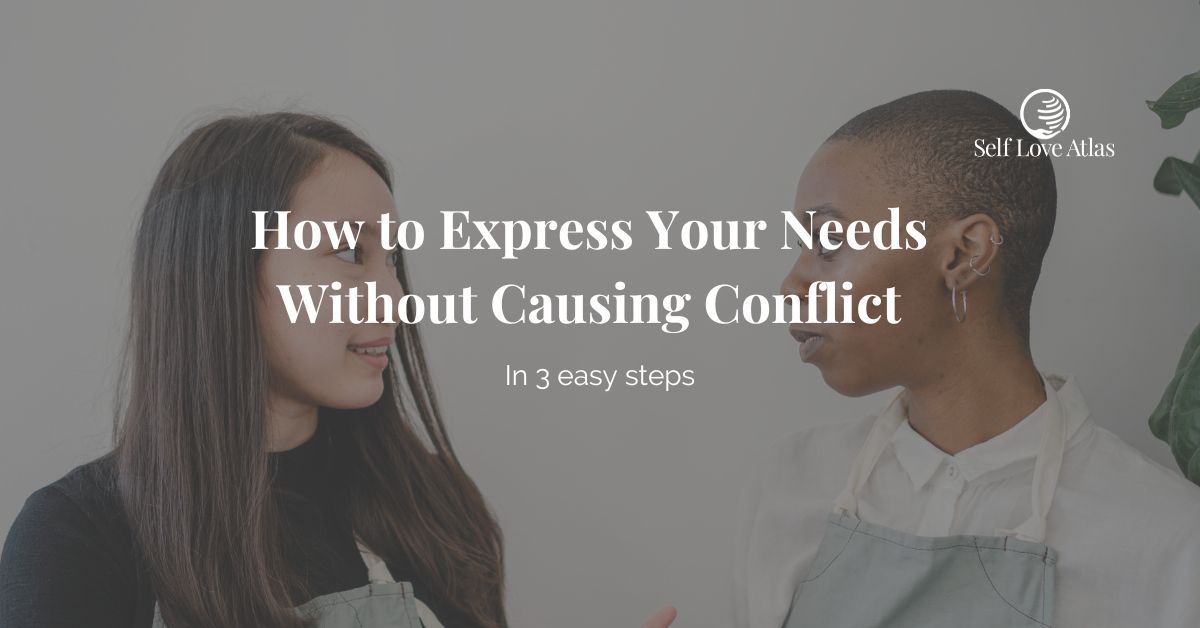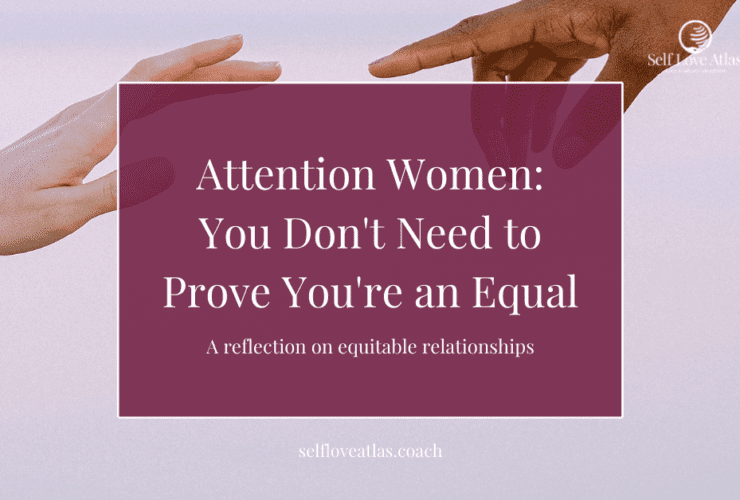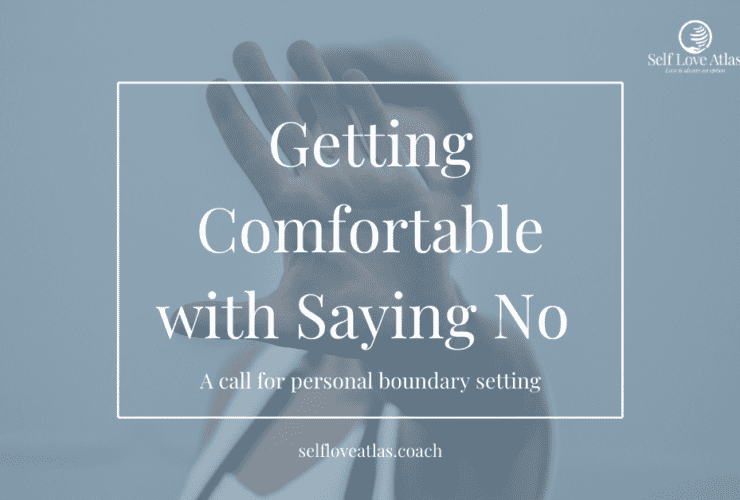How to Express Your Needs Without Causing Conflict in 3 Steps
Learning how to express your needs in any relationship can be challenging, but it doesn’t have to be.
In this post, I’ll show you three steps to expressing your needs clearly and concisely. In a way that is disarming and invites mutual understanding with the other person.
If want to feel heard and understood, but sometimes find it difficult to find the words to express what you’re looking for…
If you feel like you don’t know how to bring it up to them, or that you shouldn’t bring it up to them, because you don’t want to start anything…
Or if you’re worried that, if you tell them what’s bothering you, you’ll wind up miscommunicating and feeling even farther apart.
Then this post is for you.
Here’s how to express your needs in a relationship without causing conflict in three easy steps.
- Assume positive intent and start the conversation by verbally acknowledging that positive intent.
- Express the impact without placing blame
- Make a specific ask, and pair that ask with appreciation
I’m going to explain in detail how to do this, with examples. But trust me, you can measurably improve ANY relationship in your life, over and over again, just by using these three steps.
I’ve saved myself so many fights and miscommunications using this method. And the more you do it, the more you’ll feel heard and understood by the people around you.
Here’s why it works: these three steps make sure YOU are communicating in a way that is disarming/invites understanding. So even if someone tends to get defensive in relationship conversations, they will be able to hear you better.
And the best part is, the conversation always ends with an actionable solution (see step 3).
Step one: assume positive intent and verbally acknowledge that intent.
We start by picking a specific behavior (or words) the other person has been doing/saying that has been bothering you.
Some examples: maybe they’ve been leaving dirty dishes around the house, saying discouraging things, commenting on your appearance in hurtful ways, or not listening when you’re talking to them.
Once you’ve picked one behavior, then you intentionally interpret that behavior in a way that assumes the other person had positive intentions.
(Even if you think they had bad intentions, pretend you think they have good ones.)
In other words, approach the conversation assuming they mean you no harm, even if you think they did.
For example, if this person has been avoiding doing the dishes, or has left a mess on the table again, you might imagine that it was an honest accident or that they had a positive reason for doing it – even if you can’t imagine what that reason might be.
Then, we start a conversation by verbally acknowledging that positive intent. In this example, you would start the conversation by saying, “Hey, I know you’ve been pretty busy lately and you have a lot going on, so I totally understand that the dishes might not be on the top of your priority list…”
This is super helpful because you’re staying calm, and communicating in a way that the other person will be more receptive to what you have to say.
Assuming positive intent allows you to approach the conversation from a neutral place, and reduces the chances that the other person will get defensive. (a HUGE win for communication!)
Step one done!!! Keep trusting the process and complete the next two steps and you’ll see why this works.
Step two: express the impact without placing blame
Other people are often completely unaware of how their actions and words affect us. And they won’t have a chance to understand unless we do the uncomfortable work of telling them.
If we can muster the courage to tell them how we feel when they do this behavior, it will help them better understand our experience.
This will also give them a chance to learn to treat us how we want to be treated.
How to express the impact
When we express the impact, we want to describe only the facts of the situation, and then express the feeling we experience as a result of that situation.
For example, “I’ve noticed that when I don’t do your dishes, they sit for days. I’ve been trying to keep up with everything house wise as well as I can, but I feel exhausted and frustrated when I see those dishes start to pile up, because I don’t always have it in me to clean up everything, but I also really want us to be able to have a clean house.”
Notice how this expressing impact shares where the speaker is coming from while avoiding blame by using as much “I” language as possible.
We don’t say, “you never do the dishes” or “you’ve been so lazy this week why haven’t you been helping me with the dishes when you dirtied them?”
No. If you want this conversation to be successful, the most important part of this step is to try not to blame the other person for “making us feel” a certain way – even if we do think it’s 1000% their fault.
Is it possible that the other person could still feel blamed, even if we’re not blaming them? Yes. But we can always reassure the other person by saying, “I don’t blame you. I just wanted to share how I feel and work together to come up with a solution.”
I especially like saying “I want to work together on this” because it communicates to your partner or friend that you don’t see this situation as “me vs. you”, you see it as both of you are on the same team, the team that is working towards building a better relationship together.
How is blaming unhelpful in conversations about needs?
Blaming when we bring up our feelings can be damaging to the relationship for many reasons, but here’s why you want to avoid blaming in a conversation where you are attempting to communicate your needs…
- Placing blame can cause the other person to get defensive and become shut off from having a productive conversation.
- They’ll focus on asserting that it’s “not their fault”. But we want to remember that this conversation isn’t about whose fault it is, it’s about you getting a chance to express where you’re coming from and express what you need from this relationship, so you can work together to make the relationship work better for both of you.
- When we say “you make me feel” or use other blaming language, it can create all kinds of problems including…
- Making the other person feel like the positive things they do in the relationship are not recognized or appreciated (which, over time, can lead to them developing an attitude of “it doesn’t matter what I do, they’ll only ever notice the things I do wrong”)
- It can create a fear response in the other person (which could look like arguing or defending, leaving out of overwhelm/frustration, or silence and not knowing how to react – i.e. any of the fight, flight, or freeze responses)
- In extreme cases, it can create an unwanted or potentially manipulative power dynamic in the relationship where your partner mistakenly believes it is their job to fix all of your negative emotions (which can breed exhaustion and resentment for both people, and make the other partner feel like they are “never enough”)
Let’s be clear, expressing your needs and feelings do not cause any of these things.
It’s only when we consistently place blame and approach conversations intending to “make them see what they did wrong” that we potentially run into the problems listed above.
By following the three steps in this post, you’re protecting yourself from these outcomes, and protecting yourself from a buildup of negative emotions within yourself (which also protects your relationship from future conflict!)
Step 2 Continued…
Helpful tip: When you’re first practicing these steps, try to keep the “expressing without blaming” very short. Maybe try writing some bullet points of what you’d like to say beforehand to ensure the words are blame-free.
The more we say without checking ourselves, the more chances we have to accidentally start blaming. 😅
It could be as simple as, “I feel exhausted and overwhelmed when I see the dishes piling up.”
This is more than enough to help the other person gain a better understanding of where you’re coming from, and set you up for success in step 3.

Step 3: make a specific ask with appreciation.
The last and most important step is to make a specific ask.
As a general rule of life, if you don’t ask, you don’t receive.
People often make the mistake of assuming “my partner knows me, so they should know exactly what I want already.”
But in reality, the only way people can know for certain what you want is if you tell them!
If you assume the other person doesn’t know what you want, or what they could do to be helpful. Three good things happen.
- We feel less angry at them for not meeting our unexpressed expectations.
- We take initiative and express our needs/expectations
- The other person gains a better understanding of what we want and how they can help us.
How to Make a Specific Ask With Appreciation
For this step, start by thinking of an action the other person could take that would help you out.
Then, ask for it while expressing appreciation.
In this example, you might say, “I would appreciate it if you could prioritize doing a couple dishes per day.” Or try “It would help me if you started putting your silverware in the dishwasher. This would help both of us keep up with the house stuff. It would really be a huge help and take some weight off my shoulders. Would you be willing to do that?”
You want the action or effort you’re asking for to be something measurable and clear.
The ask is always more effective if the thing you’re asking for is specific. You want them to be able to picture themselves doing it, because then they’ll be more likely to remember to do it, and be better able to see opportunities to follow through.
DON’T ask “Could you just do better?” or “Can you please step up around the house?”
DO ask “Could you please start putting your silverware in the dishwasher after you use it?” and
DO express as much appreciation as possible.
The more thankful and appreciative you sound, the more likely the other person will WANT to help you.
Try saying things like:
“It would mean a lot to me if…”
“I would really appreciate it if…”
”It would be a huge/massive help if you could _______” etc.
All of these phrases can help the other person feel like making an effort would be meaningful and appreciated. This will make them more likely to want to help you out.
Disclaimer: Not all people will be willing to work with you or put effort into the relationship. If you express your needs multiple times without seeing any effort or acknowledgment of your feelings, then it’s worth asking “Is this the kind of relationship I want to have in my life?”
Or “are there other people or places that can help me get these needs met?”
Let’s try another example and put these 3 steps to express your needs together.
Imagine someone has been saying discouraging things to you. (Ex. “that will never work” or “I don’t think you can do that”.)
Here’s an example of how you could put together the 3 steps…
Assume & Acknowledge Positive Intent
“Hey, I know when you tell me ‘it’s not going to work’, you’re trying to help me be realistic and not get my hopes up. I understand you’re trying to protect me from disappointment”
Express Impact without Blaming
“But when you say things like that, it really discourages me and affects my confidence.”
Make a specific ask with appreciation
“It would be really helpful if you could try to keep some of those comments to yourself. Or , and I’d sincerely appreciate it if you could try to think of something more encouraging to say.”
Notice how polite and respectful this sounds!
Do you see how using these three steps can be disarming for the other person? Does it make sense how this can and increase the chances that they will be more receptive to your request?
Conclusion
If you want to communicate your needs/desires in a relationship WITHOUT causing conflict, you can use these three steps. I highly recommend practicing these by writing out what you might say before starting a conversation. This can help build your confidence with communicating your feelings and asking for what you want!
- assume & acknowledge positive intent
- express the impact without blame
- make a specific ask with appreciation
These will help reduce defensiveness in the conversation AND improve your interactions with one another.
The more you communicate your needs, the more your relationships will feel better – one step at a time!
Note: it is perfectly okay to allow space for conversation between steps. The person you’re speaking with might have questions, or need reassurance that you’re on the same team.
If you have any questions about how to apply these steps to one of your relationships, leave a comment below!
Much love,
Morgan Rita
If you’re new here, I’m Morgan! I’m a certified life coach for perfectionists and high achievers. My mission is to help people build confidence and self-esteem sustainably, so you can get your energy for life back. To get started on your own journey, sign up for the Self Love Atlas Newsletter below (it’s free).
For more uplifting content, check out some other posts on my blog, or follow me on instagram @morgan_barbret





